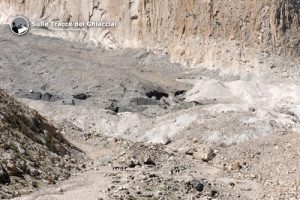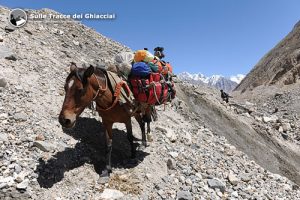We moved from Urdukas to Payu, and as described in the last article by Pino we met really innumerable upd and downs. During the trip we also found many historic viewpoints, especially those of Vittorio Sella. But let us proceed with order …
Last night was quite tormented in terms of photography: during a long exposure of five hours to return the stellar tracks on the Trango Towers, I had to continually discuss with Rasool, our cook, to make him take off the lights of the kitchen tent, and then with the camp’s operators, since every hour and for no apparent reason, they turned on the field lights. Incredible, I had to fight against light pollution even here, in the Karakoram!
The next morning, despite the few hours of sleep, I took a nice group portrait with all our carriers on the Urdukas panoramic rock, and immediately after an image of the Payu Towers, as already obtained by Vittorio Sella in 1909.
Leaving Urdukas, after about 2 hours of walking, we reach the Liligo glacier, and with Pino we carried out GPS measurements along the whole front. Yet from the instrumental measurements we can see that, compared to images and measurements taken by the geologist Massimo Pecci in 1997, in which the front was about 50 meters away from the Baltoro glacier, currently the front is at least 100 meters away from the Baltoro, thus clearly being in a withdrawal phase.
We also take many panoramic photographs, useful to retrieve a broad overview of the entire glacier.
Arrived at the old Liligo’s camp, with photos in hand, I broke away from the caravan to climb on a debris channel in search of a new photography viewpoint used by Vittorio Sella. The prospect of the mountains in front of me is the right one, although not perfectly coincident with the historic image; to find the exact point of shooting I’m forced to move laterally, with much more struggling.
I am excited to say the least: I was sure, the changes of the glacier at this point are very clear, and can be seen at a glance: the height of the glacier has been reduced by several tens of meters during the last century. Then I began the usual long photographic procedure: install the tripod, then the Linhof folding camera, choose the most appropriate lens in order to better reproduce better the historic shot, focus with the loupe on the ground glass with the help of black cloth , put in the bubble level, take the exposure with the external exposure meter, arm the shutter, close the lens, mount the flexible, pull out the volet and here we are, we are ready to shoot at last!
Shortly after I arrive at the Liligo’s camp, where the others had stopped for lunch: a small table, as tradition, has been set up at the edge of the moraine, and despite the warm weather food and drinks are served heated. This too is normal, the water taken from the stream must first boiled for hygienic issues. The desire for a nice cold beer is always stronger!
Immediately after, always at the Liligo’s camp, I replied another image by Vittorio Sella on the Payu mountain, just above the Uli Biaho glacier. Even in this picture, though made at a different daytime, I can notice that the ice shelves have withdrawn in the last hundred years. We are well aware that the chain of the Karakorum glaciers didn’t undergone great changes, especially thanks to the cover of surface debris that prevents ice from bein ablated, but it is clear that global warming is affecting these areas too, even though to a lesser extent than other mountain such as our Alps.
Tomorrow we’ll be back on the front of the Baltoro glacier to make other measurements, such as to assess the distance of the front from the Desio rock, and to search for two more historic photographic viewpoints.














…quasi, quasi peccato stiate rientrando!
Cmq la lenta via del ritorno continua a riservarci
interessanti fotografie e simpatici ed incisivi racconti
Ancora grazie
Ciao Fabiano,
non ho nessuna idea di cosa possano essere 5 ore di esposizione, da appassionato di fotografia mi viene da dire “fantastico”!
Così come sono fantastiche le tue foto!
Oggi le guardavo e pensavo: ma chi siamo noi umani per distruggere tutto questo! Sicuramente non meritiamo un pianeta così bello!
Continua così Fabiano.
Complimenti sinceri,
Matteo Giardino
Ciao Fabiano,
le foto che continui a pubblicare sul sito sono veramente belle, nell’osservarle si ha la percezione di una natura selvaggia, dominante ed eterna, anche se purtroppo nel confronto con le foto storiche si evince che l’opera distruttiva dell’uomo non è stata ininfluente ed è arrivata anche in questi luoghi.
Complimenti a te e a tutto lo staff. Credo di poter affermare, anche se la mia opinione e solo quella di un fotografo amatoriale, che lo scopo fotografico della missione sia stato ampiamente raggiunto vista la perfetta somiglianza tra le tue foto e quelle storiche: persino la posizione delle ombre è la stessa !!! Incredibile!!! Veramente tanti complimenti, complimenti per la determinazione, per l’accuratezza, e soprattutto per la capacità …… Complimenti a tutti.
oggi sono riuscita a rimettermi finalmente un po’ a paro con i vostri racconti sempre emozionanti! e’ si quasi quasi peccato che state rientrando. buon rientro.
Ciao Fabiano,
bellissime foto come sempre: e’ impressionante quanto si e’ abbassato il ghiacciaio rispetto alla foto di Vittorio Sella. Non vedo l’ora di vedere le foto di notte. Buon rientro a casa.
Dear Fabiano i have no words to describe u and ur work…. Amazing and wonderfull pictures….really ur the best best best photgrapher of the world…..i really like all the pictures and i really appircated u….
God bless u…
Ehsan Islamabad pakistan